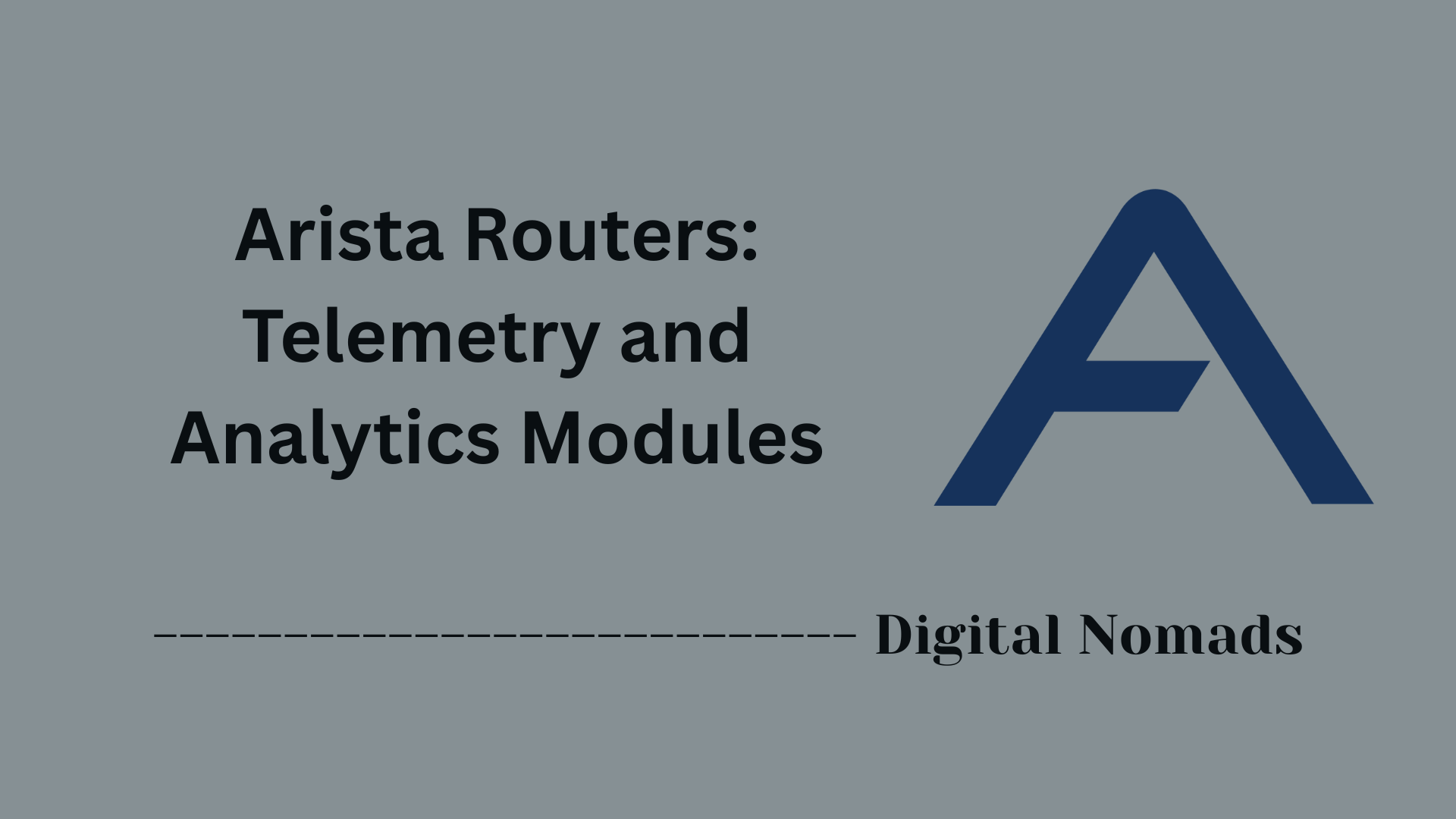Table of Contents
- Overview
- Arista EOS: Technical Highlights
- Summary of Advanced Capabilities
- Application Scenarios
- Conclusion
Arista Routers & Arista Extensible Operating System (EOS): Overview
What Is It?
Arista Routers are high-performance network devices engineered for modern data center, cloud, and enterprise environments. They are designed to provide efficient routing, scalability, and robust security across a range of use cases, from edge and core enterprise deployments to service provider and hyperscale data centers.
Arista Extensible Operating System (EOS) is the network operating system that powers Arista routers and switches. EOS is built from the ground up on an unmodified Linux kernel, implementing a modular, multi-process architecture. This design offers exceptional reliability, programmability, and operational flexibility compared to traditional network operating systems.
Why You Need to Know About It
- Modern Network Demands: As enterprises embrace cloud computing, AI/ML workloads, and hybrid architectures, network infrastructure must be agile, scalable, and easily automatable. Arista delivers this with its EOS-driven routers.
- Operational Efficiency: EOS unifies hardware support under a single software image, simplifying software updates, troubleshooting, and lifecycle management across diverse network hardware.
- Programmability & Openness: For organizations adopting DevOps practices or automation frameworks, EOS offers extensive APIs, scripting support, and seamless integration with third-party tools, lowering both administrative overhead and time-to-deployment.
- Reliability & Innovation: With live patching, stateful process restarts, and agent isolation, EOS provides high availability—reducing downtime for mission-critical applications and services.
- Security and Compliance: Advanced security features and deep visibility help organizations maintain safe, compliant, and segmented network environments.
How It Works
- Linux Foundation: EOS operates atop an unmodified Linux kernel. This enables direct integration with standard Linux tools, custom scripts, and containers, making the platform familiar to network and system administrators.
- Modular Architecture: Network features in EOS are implemented as independent software processes (agents). Each agent manages specific network functions (such as routing, management, etc.), and communicates via a centralized in-memory database (SysDB) that stores and synchronizes the state across the system.
- Fault Isolation & Live Patching: If one agent or process fails, it can be restarted independently without affecting the rest of the system or causing device reboots. Software updates and patches to specific modules can be applied on-the-fly, ensuring continuous network operation.
- Single Binary Model: Every device, regardless of its hardware form factor, runs the same EOS image. This streamlines deployment, upgrades, and troubleshooting, as operational behavior remains consistent across the network.
- Extensive APIs & Integrations: EOS supports RESTful APIs, eAPI (JSON-RPC), and integrations with popular automation tools like Ansible, Puppet, and Chef. Operators can automate provisioning, configuration, monitoring, and troubleshooting tasks easily.
- Visibility & Analytics: Built-in telemetry, event streaming, and integration with Arista CloudVision provide deep insights into network health, traffic patterns, and performance, enabling proactive monitoring and rapid troubleshooting.
Arista Routers and EOS together provide a powerful, flexible, and future-ready networking solution that supports the demands of both enterprise and cloud-scale environments.
Arista EOS: Technical Highlights
Arista Extensible Operating System (EOS) stands out through its innovative architecture and advanced feature set designed for modern network environments:
- Foundational Linux Architecture: Built on an unmodified Linux kernel, EOS leverages the stability, flexibility, and vast ecosystem of Linux, making it familiar to network and DevOps teams alike.
- Agent-Based Processes: All network functions are handled by independent software agents, isolating faults, increasing reliability, and enabling stateful process restarts without impacting service.
- SysDB State Management: A central in-memory database (SysDB) maintains device state separately from processes, ensuring quick convergence and minimal disruption during upgrades or failures.
- Single Binary Image: One consistent EOS binary operates across all hardware, simplifying updates, reducing operational complexity, and providing a uniform experience.
- Programmability & Open APIs: Supports eAPI (JSON-RPC), SDKs, Linux scripting, and event-driven automation. Integrates seamlessly with DevOps and orchestration tools.
- Extensibility: Allows installation of custom applications, containers, and native Linux tools. Supports live patching of software components and user-driven enhancements.
- CloudVision Integration & Automation: Native integration with Arista CloudVision provides comprehensive management, telemetry, and large-scale automation for network operators.
- Advanced Telemetry & Visibility: Offers full-state telemetry through NetDB, real-time analytics, and compatibility with monitoring solutions like Splunk and sFlow for deep network visibility.
Summary of Advanced Capabilities
Arista EOS provides a comprehensive set of advanced capabilities that differentiate it from traditional network operating systems:
- Live Patchability: Enables updating individual software modules and components without rebooting the device or disrupting network services, ensuring high availability.
- Device Portability: The same EOS software image runs across all supported hardware platforms, from fixed switches to modular routers, simplifying management and reducing operational complexity.
- Open Platform: EOS supports open standards, Linux-based tools, and extensibility, allowing users to integrate third-party applications and apply DevOps best practices.
- Programmability & Automation: Features native APIs, scripting support, and integration with automation frameworks to enable efficient, repeatable network operations.
- Scalability & Performance: Designed to handle large-scale, high-performance environments, EOS optimizes resource utilization and supports modern workload demands such as cloud, AI, and 5G.
Application Scenarios
Arista EOS powers a wide range of network environments across industries by leveraging its programmable, scalable, and resilient architecture. Here are some core application scenarios:
- Data Center and Cloud Networking: Designed for modern data centers and cloud providers, EOS supports massive scale-out, multi-cloud, and hybrid cloud environments. It enables open, programmable architectures for rapid workload mobility, unified management, and integration with AI/ML workloads and containerized applications.
- Enterprise WAN and Campus Deployments: Used as the software foundation for high-performance WAN routing and aggregation, Arista EOS enables flexible, secure connectivity in campus and branch environments. Advanced traffic engineering and automation tools help streamline WAN operations and provide easier cloud on-ramp and branch interconnect options.
- Edge Routing and Aggregation: Supports secure, high-throughput aggregation and edge applications, including support for SD-WAN architectures, with consistent EOS functionality across virtual, cloud, and physical appliances.
- Service Provider and Peering Networks: Delivers programmable traffic steering, robust IP peering, and high-density, deep-buffer designs tailored to the needs of service providers, CDNs, and internet exchanges. EOS technologies like FlexRoute and AlgoMatch enhance performance and visibility for large-scale routing and monitoring.
- Vertical-Specific Solutions: Arista EOS platforms are trusted in industry verticals such as financial services (low latency trading), healthcare (secure data transmission), manufacturing (industrial automation), and media/entertainment (content delivery), owing to their high performance, reliability, and regulatory compliance.
Conclusion
Throughout this blog post, we’ve explored the modern networking landscape shaped by Arista Routers and the Arista Extensible Operating System (EOS). Here’s a review of the most important insights:
- What sets Arista EOS apart: EOS is built on a Linux-based, modular architecture where processes (“agents”) are independent, meaning faults remain self-contained and problematic components can be restarted or even patched live—without impacting network operations. This leads to exceptional resiliency and uptime, qualities essential for today’s demanding network environments.
- Unified software experience: A single EOS binary image runs across all Arista hardware platforms, greatly simplifying software management and ensuring consistent performance, features, and reliability no matter which devices are deployed.
- Programmability and openness: EOS embraces open standards and offers rich programmability through APIs, Linux shell access, scripting, and integrations with automation tools. This enables organizations to automate everything from device provisioning to daily operations, improving agility and reducing human errors.
- Network visibility and analytics: With its real-time telemetry, in-memory state database, and robust integration with network monitoring tools, EOS provides deep observability. Operators can monitor, analyze, and troubleshoot their networks proactively using native features designed to deliver detailed insights.
- Scalability for the cloud era: Whether connecting a few hundred devices or scaling out to networks of tens of thousands of compute nodes, Arista EOS was designed for high performance, flexibility, and cloud-scale growth, supporting advanced features for seamless network virtualization and efficient bandwidth utilization.
- Security and extensibility: Arista’s architecture supports the deployment of custom agents, containers, and third-party applications securely, while maintaining the integrity and isolation of critical services. This combination empowers organizations to tailor their networks to their unique needs.
Key takeaway:
Arista Routers with EOS deliver future-ready networking—combining reliability, openness, automation, and deep visibility into a platform trusted by the world’s most demanding enterprises and cloud operators.
Thank you for joining us on this journey into Arista’s innovative networking approach! If you’re planning your next network build, exploring ways to make your operations more agile, or just fascinated by leading-edge infrastructure, Arista EOS is definitely worth a closer look. Until next time—happy networking!




